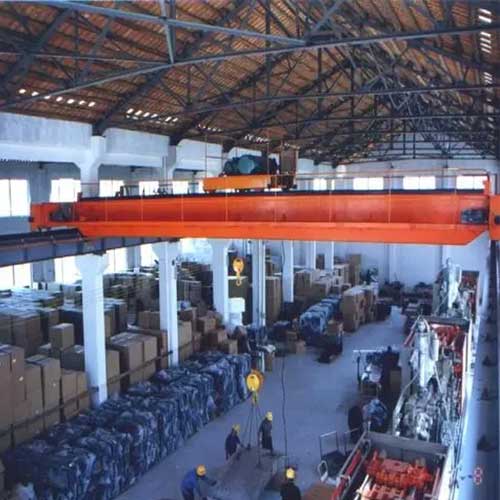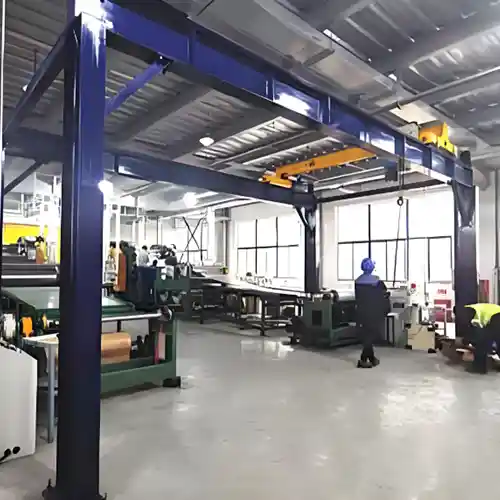Manufacturing Cranes | General Manufacturing Industrial Crane
Overhead cranes for general manufacturing. All types of industrial overhead cranes, gantry cranes, jib cranes for selection 5 ton, 10 ton, 20 ton, 50 ton.
| Overhead crane | All typs of overhead cranes for general manufacturing |
| Crane capacity | 0.5- 80 ton |
| Note | Custom manufacturing cranes are provided based on your applications. |
Category: Indoor Crane
Your Trusted Overhead Manufacturing Crane Manufacturer & Supplier
Maufacturing Cranes,Custom General Manufacturing Industrial Cranes
Overhead Cranes for General Manufacturing 5 Ton, 10 Ton, 20 Ton, 50 Ton
Overhead cranes for general manufacturing. All types of industrial overhead cranes, gantry cranes, jib cranes for selection 5 ton, 10 ton, 20 ton, 50 ton.
Title: "Elevate Efficiency: Your Comprehensive Guide to Manufacturing Cranes"
Manufacturing cranes are the unsung heroes of countless industries, working tirelessly behind the scenes to move heavy materials, streamline production, and elevate efficiency. In this comprehensive guide, we will embark on a journey through the world of manufacturing cranes, exploring their various types, features, benefits, and typical applications. Whether you're a seasoned crane user or a potential purchaser looking to optimize your operations, this guide is your key to unlocking the full potential of these remarkable machines.
The Crucial Role of Manufacturing Cranes
Picture a bustling manufacturing facility where raw materials are transformed into finished products. At the heart of this operation stands the manufacturing crane, an indispensable workhorse that takes center stage in the choreography of production. These cranes are designed to shoulder the heavy lifting, allowing workers to focus on what they do best – creating, assembling, and innovating.
Manufacturing cranes are the backbone of industries such as automotive, aerospace, construction, and many more. They ensure that materials and components are precisely positioned, materials are efficiently transported, and machinery is lifted into place with utmost precision. Without them, the gears of production would grind to a halt.
How Manufacturing Cranes Enhance Efficiency
Efficiency is the name of the game in modern manufacturing, and manufacturing cranes are the players that ensure victory. These powerful machines bring a multitude of benefits to the table:
- A. Precision and Speed: Manufacturing cranes are engineered for precision. They can move heavy loads with pinpoint accuracy, minimizing errors and reducing production times. Whether it's lifting an engine block into place or transporting materials across a sprawling warehouse, speed and accuracy are the hallmarks of these cranes.
- B. Safety: Safety is paramount in any manufacturing environment. Manufacturing cranes are equipped with safety features and fail-safes to protect both workers and materials. Their precision controls and well-designed mechanisms make accidents a rarity.
- C. Space Optimization: With their ability to move loads vertically and horizontally, manufacturing cranes optimize floor space. This is particularly vital in crowded facilities, allowing for efficient material flow and better organization.
- D. Versatility: Manufacturing cranes come in various types, each suited for specific tasks. From overhead bridge cranes that span vast workspaces to compact jib cranes for localized lifting, there's a crane for every job.
- E. Reduced Labor Costs: By automating heavy lifting tasks, manufacturing cranes reduce the need for manual labor, saving on labor costs and minimizing the risk of worker fatigue or injuries.
As we delve deeper into this guide, we will explore the various types of manufacturing cranes, their features, benefits, and typical applications, shedding light on how they can be tailored to suit your specific industry needs. Stay with us as we uncover the secrets to success in manufacturing through the power of cranes.
Types of Manufacturing Cranes
Manufacturing cranes come in a variety of types, each designed to excel in specific tasks and environments. In this section, we'll explore the five primary types of manufacturing cranes, highlighting their distinctive features, benefits, and typical applications.
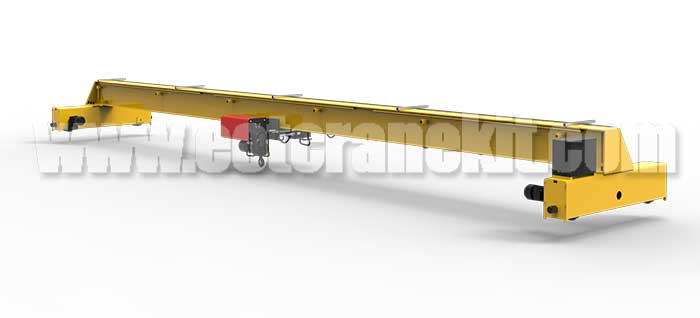
Features and Benefits:
- 1. Exceptional Load Capacity: Overhead bridge cranes are known for their impressive load-bearing capabilities. They can effortlessly handle heavy materials and equipment, making them ideal for industries like steel manufacturing and construction.
- 2. Versatile Movement: These cranes offer both horizontal and vertical movement. They can traverse the length of your facility with ease, reaching every corner, and can lift loads to great heights with precision.
- 3. Reduced Floor Obstruction: Overhead cranes operate from above, minimizing obstructions on the factory floor. This allows for efficient material handling and better workspace utilization.
- 4. Enhanced Safety: Equipped with advanced safety features such as limit switches and overload protection, overhead bridge cranes provide a secure working environment.
Typical Applications:
- Loading and unloading heavy machinery
- Moving steel beams and coils
- Assembly line operations in manufacturing plants
- Shipyard and dockside operations
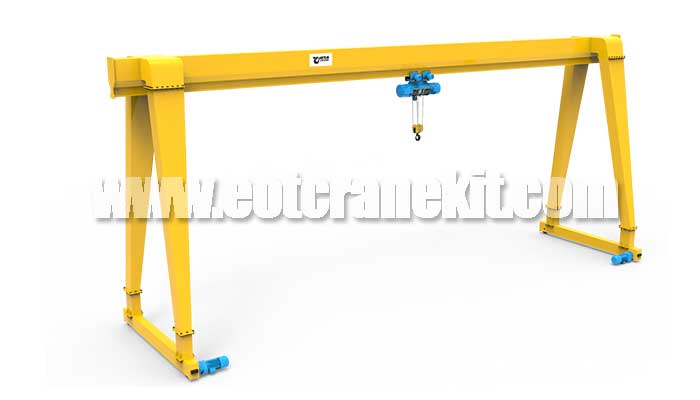
Features and Benefits:
- 1. Mobility: Gantry cranes are mounted on wheels or rails, giving them the ability to move horizontally along a fixed path. This makes them suitable for both indoor and outdoor applications.
- 2. Stability: Their wide-span design provides stability when lifting heavy loads, ensuring that materials remain secure during transport.
- 3. Flexible Load Handling: Gantry cranes can be equipped with various lifting attachments, making them adaptable for a wide range of materials and tasks.
- 4. Space Efficiency: These cranes require minimal floor space, making them an excellent choice for facilities with space constraints.
Typical Applications:
- Container handling in ports and shipyards
- Outdoor construction sites
- Loading and unloading materials from trucks
- Maintenance and repair operations
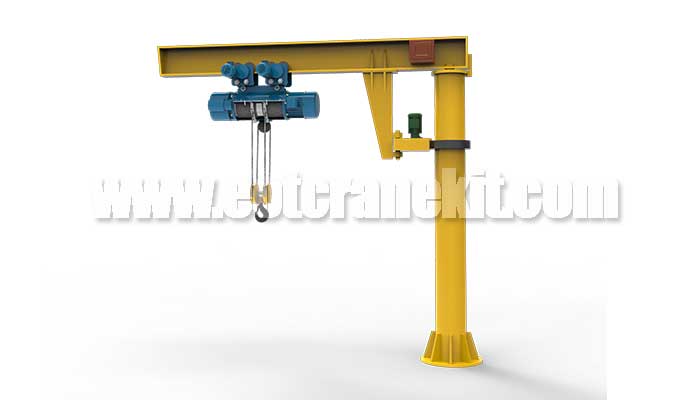
Features and Benefits:
- 1. 360-Degree Rotation: Jib cranes have a vertical mast with a horizontal boom that can rotate a full 360 degrees, offering exceptional reach and flexibility.
- 2. Precise Load Placement: These cranes provide precise control for positioning materials or equipment, making them ideal for assembly lines and workstations.
- 3. Compact Design: Jib cranes are space-saving solutions, perfect for areas where floor space is limited.
- 4. Cost-Effective: They are often a cost-effective alternative for localized lifting tasks.
Typical Applications:
- Machine shop workstations
- Loading and unloading materials from machinery
- Assembly lines
- Small-scale manufacturing operations

Features and Benefits:
- 1. Single Rail Design: Monorail cranes operate on a single overhead rail, making them ideal for material transport along a predetermined path.
- 2. Compact and Space-Efficient: They are suitable for small work areas where floor space is limited.
- 3. Customizable Configurations: Monorail systems can be customized with various load-handling attachments to suit specific tasks.
- 4. Precision Movement: These cranes offer precise control for transporting materials with minimal effort.
Typical Applications:
- Automotive assembly lines
- Paint and finishing processes
- Material transport along a fixed path
- Lean manufacturing environments
Understanding the strengths and capabilities of these manufacturing crane types is crucial for choosing the right one to optimize your specific industrial processes. In the next section, we will delve deeper into how each of these crane types can transform your operations.
Optimizing Operations: Industrial Applications
Now that we've explored the various types of manufacturing cranes and their features, it's time to uncover the real-world applications where these cranes shine, revolutionizing industrial operations and optimizing efficiency.
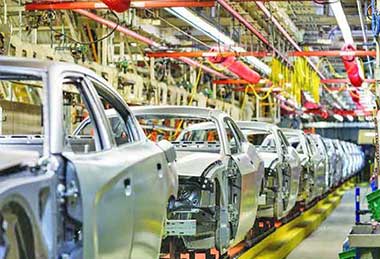
- Overview of Automotive Manufacturing:Automotive manufacturing involves the assembly of vehicles, including cars, trucks, and motorcycles. It is a complex process that requires precise handling and positioning of heavy components and equipment.
- Types of Manufacturing Cranes Used:Overhead bridge cranes, jib cranes, and gantry cranes are commonly used in automotive manufacturing.
- Crane Configurations:Overhead bridge cranes are often installed along the assembly line, while jib cranes are used for localized tasks, and gantry cranes provide versatility.
- Features of Manufacturing Cranes for Automotive:These cranes have high load capacities, precision controls, and safety systems.
- Main Functions and Applications:They are used for lifting and positioning components like engines, chassis, and body frames, contributing to assembly line efficiency and product quality.
Aerospace Industry
- Overview of Aerospace Industry:The aerospace industry focuses on the design, manufacturing, and assembly of aircraft, spacecraft, and related components, demanding precision and safety.
- Types of Manufacturing Cranes Used:Overhead bridge cranes, gantry cranes, and specialized aircraft assembly cranes.
- Crane Configurations:These cranes are equipped to handle large and heavy aircraft components with precision.
- Features of Manufacturing Cranes for Aerospace:High load capacity, precision, and advanced safety systems are crucial features.
- Main Functions and Applications:Cranes in aerospace are used for handling and assembling large components like wings, fuselages, engines, and landing gear.
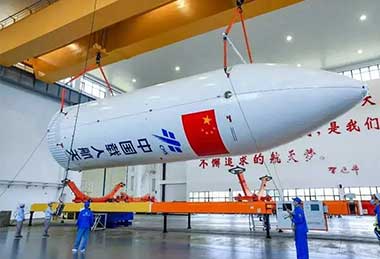
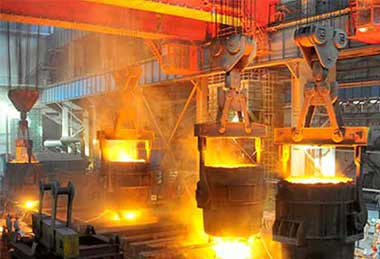
- Overview of Steel and Metalworking:Steel mills and metalworking facilities are involved in the production and processing of metal products, requiring efficient material handling.
- Types of Manufacturing Cranes Used:Overhead bridge cranes, gantry cranes, and magnetic cranes.
- Crane Configurations:These cranes are tailored for transporting heavy metal materials and shaping metal sheets.
- Features of Manufacturing Cranes for Steel and Metalworking:They have high load capacity, durability, and material-specific attachments.
- Main Functions and Applications:These cranes transport raw materials such as steel coils and beams, manipulate metal sheets, and assist in shaping molds.
- Overview of Construction:The construction industry involves building infrastructure and structures, requiring the lifting and placement of heavy construction materials.
- Types of Manufacturing Cranes Used:Mobile cranes, tower cranes, and crawler cranes are common in construction.
- Crane Configurations:Mobile cranes are versatile, tower cranes are stationary, and crawler cranes excel in rough terrain.
- Features of Manufacturing Cranes for Construction:Variable load capacity, mobility, and reach are critical.
- Main Functions and Applications:Cranes in construction lift and place materials like concrete blocks, steel girders, and prefabricated components at construction sites.
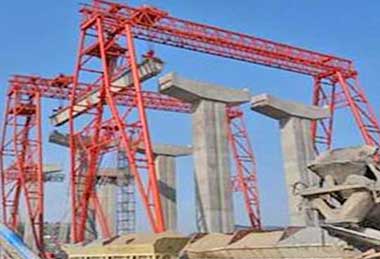
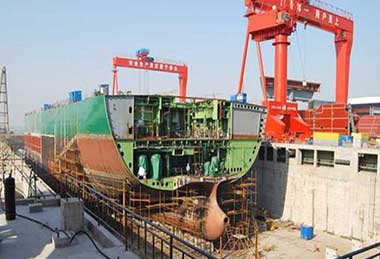
- Overview of Shipbuilding:Shipyards are involved in building vessels, necessitating the handling of massive ship components.
- Types of Manufacturing Cranes Used:Shipyard gantry cranes, dockside cranes, and mobile cranes are prevalent.
- Crane Configurations:These cranes have high load capacity and long reach.
- Features of Manufacturing Cranes for Shipbuilding:They are designed for the efficient assembly of ship components.
- Main Functions and Applications:These cranes handle ship sections, assist in loading and unloading cargo from ships, and maintain shipyard equipment.
- Overview of Warehouse and Logistics:Warehousing and distribution centers focus on the storage and retrieval of goods, requiring efficient material handling.
- Types of Manufacturing Cranes Used:Stacker cranes, automated guided vehicles (AGVs), and monorail systems.
- Crane Configurations:Stacker cranes maximize storage space, AGVs are automated for material retrieval, and monorail systems provide high-bay warehousing.
- Features of Manufacturing Cranes for Warehouse and Logistics:These cranes offer high-density storage and automation.
- Main Functions and Applications:They facilitate automated storage and retrieval, optimizing distribution center operations and high-bay warehousing.
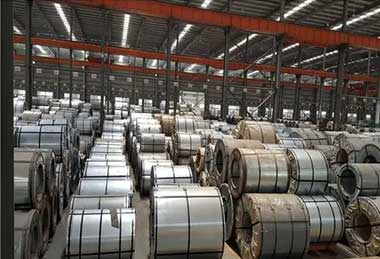
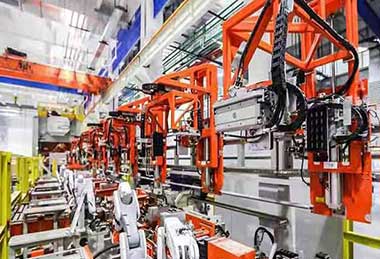
Manufacturing and Assembly Lines
- Overview of Manufacturing and Assembly Lines:Manufacturing and assembly involve the production of products, necessitating material handling and positioning.
- Types of Manufacturing Cranes Used:Overhead bridge cranes, jib cranes, and monorail systems are common.
- Crane Configurations:These cranes provide precision controls and automation options.
- Features of Manufacturing Cranes for Manufacturing and Assembly:They accelerate production, reduce labor costs, and ensure precise assembly.
- Main Functions and Applications:These cranes are used for material handling, component assembly, and product positioning in various industries.
Mining and Extractive Industries
- Overview of Mining and Extractive Industries:These industries involve extracting minerals and resources from the Earth, requiring heavy equipment and material transport.
- Types of Manufacturing Cranes Used:Dragline cranes, excavator cranes, and mobile cranes are common.
- Crane Configurations:These cranes are designed for heavy-duty operations and harsh environments.
- Features of Manufacturing Cranes for Mining:They offer heavy load capacity, durability, and adaptability.
- Main Functions and Applications:Cranes in mining transport heavy equipment, materials, and perform excavation tasks.
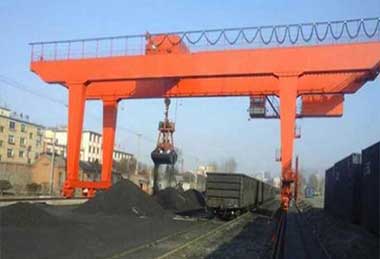
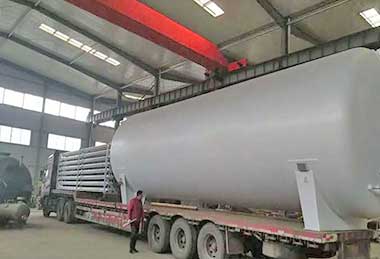
- Overview of Oil and Gas Sector:This sector encompasses exploration, drilling, refining, and processing of oil and gas resources.
- Types of Manufacturing Cranes Used:Offshore cranes, pedestal cranes, and mobile cranes are employed.
- Crane Configurations:These cranes handle heavy equipment and operate in challenging environments.
- Features of Manufacturing Cranes for Oil and Gas:High load capacity, precision controls, and corrosion resistance are essential.
- Main Functions and Applications:These cranes are used for lifting equipment, handling materials on offshore platforms, and maintenance operations.
- Overview of Renewable Energy:Renewable energy involves harnessing energy from sources like wind and solar, requiring the assembly of renewable energy infrastructure.
- Types of Manufacturing Cranes Used:Wind turbine installation cranes and mobile cranes.
- Crane Configurations:These cranes have high reach, precision, and adaptability.
- Features of Manufacturing Cranes for Renewable Energy:They ensure safe and efficient assembly of wind turbines and solar panels.
- Main Functions and Applications:These cranes are used for installing wind turbine components and positioning solar panels.
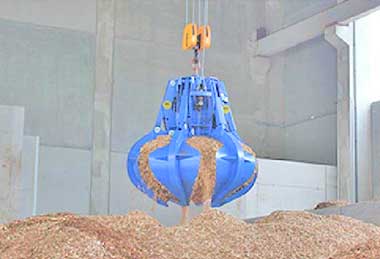
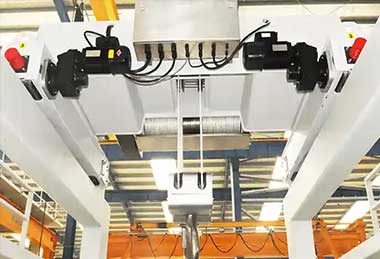
Food and Beverage
- Overview of Food and Beverage:The food and beverage industry involves the production, packaging, and distribution of consumable products, necessitating material handling.
- Types of Manufacturing Cranes Used:Overhead bridge cranes, monorail systems, and jib cranes are employed.
- Crane Configurations:These cranes ensure hygienic design, precision controls, and corrosion resistance.
- Features of Manufacturing Cranes for Food and Beverage:They enable efficient material handling and equipment maintenance.
- Main Functions and Applications:These cranes lift and position containers, equipment, and raw materials in food processing plants.
- Overview of Paper and Pulp Manufacturing:This industry involves the production of paper and pulp products, demanding efficient material handling.
- Types of Manufacturing Cranes Used:Overhead bridge cranes, gantry cranes, and jib cranes.
- Crane Configurations:These cranes are equipped for transporting and maintaining production machinery.
- Features of Manufacturing Cranes for Paper and Pulp:They offer durability, precision controls, and safety features.
- Main Functions and Applications:These cranes handle paper rolls, pulp, and assist in maintaining production equipment.
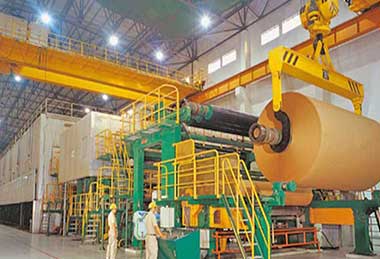
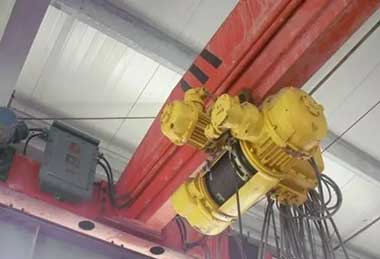
Pharmaceutical and Chemical Industries
- Overview of Pharmaceutical and Chemical Industries:These industries focus on producing pharmaceuticals and chemicals, requiring precise material handling.
- Types of Manufacturing Cranes Used:Overhead bridge cranes, explosion-proof cranes, and cleanroom cranes.
- Crane Configurations:These cranes are designed for handling chemical containers, reactors, and processing equipment.
- Features of Manufacturing Cranes for Pharmaceuticals and Chemicals:They offer corrosion resistance, precision controls, and safety features.
- Main Functions and Applications:These cranes handle chemicals, pharmaceutical ingredients, and assist in equipment positioning.
- Overview of Textile Manufacturing:The textile industry involves producing textiles and fabrics, requiring efficient material handling.
- Types of Manufacturing Cranes Used:Overhead bridge cranes, jib cranes, and monorail systems are employed.
- Crane Configurations:These cranes transport and position rolls of fabric and machinery in textile mills.
- Features of Manufacturing Cranes for Textiles:They offer durability, precision controls, and safety features.
- Main Functions and Applications:These cranes handle rolls of fabric, maintain textile machinery, and ensure efficient production.
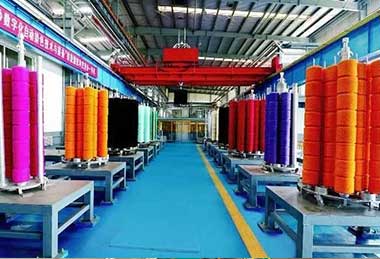
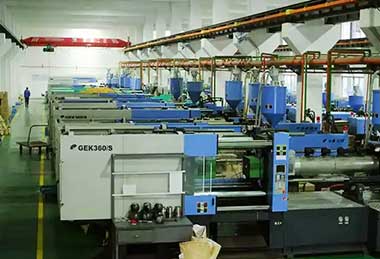
Plastics and Rubber Production
- Overview of Plastics and Rubber Production:This industry involves manufacturing plastic and rubber products, necessitating efficient material handling.
- Types of Manufacturing Cranes Used:Overhead bridge cranes, gantry cranes, and vacuum lifting systems are common.
- Crane Configurations:These cranes handle raw materials and large molds in plastic and rubber manufacturing processes.
- Features of Manufacturing Cranes for Plastics and Rubber:They offer durability, material-specific attachments, and precision controls.
- Main Functions and Applications:These cranes transport raw materials, molds, and assist in maintaining production equipment.
Each industry relies on specific types of manufacturing cranes tailored to its unique needs, enabling efficient material handling, precision positioning, and enhanced productivity. The choice of crane type and features depends on the industry's specific requirements and challenges.
Understanding Crane Cost and Pricing
Investing in a manufacturing crane is a strategic decision that can significantly impact your operations and bottom line. However, the cost and pricing of these machines can vary widely depending on several factors. In this section, we will delve into the intricacies of crane costs, the total cost of ownership, and how to budget effectively for the acquisition of a manufacturing crane.
A. Factors Affecting Crane Cost
The cost of a manufacturing crane is influenced by a multitude of factors, and understanding these variables is essential for making an informed decision:
- 1. Crane Type and Configuration: Different crane types come with varying price tags. Overhead bridge cranes, for example, tend to be more expensive due to their load-bearing capacity and complexity compared to jib cranes or monorail cranes.
- 2. Load Capacity: The crane's capacity to lift and move loads is a significant cost determinant. Higher load capacities require more robust and costly components.
- 3. Span and Reach: The span (distance between runway supports) and reach (horizontal coverage) of the crane impact its cost. Longer spans and larger reaches require more materials and engineering.
- 4. Automation and Technology: Advanced automation features, such as remote controls, anti-collision systems, and precise positioning technology, can increase the cost but often result in greater efficiency.
- 5. Customization: Tailoring the crane to your specific needs, including specialized attachments and features, can add to the cost.
- 6. Installation and Site Preparation: Crane installation and site preparation, including structural modifications, electrical work, and safety features, contribute to the overall expense.
- 7. Maintenance and Service Contracts: Factor in ongoing maintenance costs and the availability of service contracts when considering the total cost of ownership.
B. Evaluating the Total Cost of Ownership
When evaluating the cost of a manufacturing crane, it's crucial to look beyond the initial purchase price. The total cost of ownership (TCO) encompasses all expenses associated with owning and operating the crane throughout its lifespan. Consider the following aspects:
- 1. Maintenance and Repairs: Regular maintenance is essential to keep the crane in optimal condition. Budget for maintenance costs, spare parts, and potential repairs.
- 2. Energy Consumption: Cranes consume electricity during operation. Assess the long-term energy costs associated with the crane.
- 3. Downtime Costs: Calculate the financial impact of downtime caused by crane breakdowns or maintenance. Minimizing downtime can have significant cost benefits.
- 4. Operator Training: Proper operator training is essential for safe and efficient crane operation. Include training costs in your TCO analysis.
- 5. Lifespan and Resale Value: Estimate the crane's expected lifespan and potential resale value. A high-quality crane may have a longer lifespan and retain value better.
C. Budgeting for Crane Acquisition
When budgeting for the acquisition of a manufacturing crane, follow these steps to ensure a well-informed decision:
- 1. Define Your Needs: Determine your specific requirements, including load capacity, reach, and automation features.
- 2. Request Quotes: Obtain quotes from reputable crane manufacturers and suppliers. Compare multiple options to find the best fit for your budget.
- 3. Consider Financing Options: Explore financing options such as leases, loans, or rental agreements to spread the cost over time.
- 4. Account for Installation and Site Preparation: Include the cost of crane installation, structural modifications, and any necessary site preparation work.
- 5. Factor in Operating Costs: Estimate ongoing operating costs, including maintenance, energy consumption, and potential downtime expenses.
- 6. Evaluate ROI: Calculate the potential return on investment by assessing how the crane will improve efficiency, reduce labor costs, and increase productivity.
By carefully considering all these factors and evaluating the total cost of ownership, you can make a budget-conscious decision that aligns with your operational needs and long-term financial goals. In the next section, we'll address the top concerns of manufacturing crane users, ensuring that your investment is not only cost-effective but also safe and efficient.
Top Concerns of Manufacturing Crane Users
Manufacturing cranes are powerful tools that significantly enhance operations, but they also come with important considerations and concerns. Ensuring safety, proper maintenance, skilled crane operators, and minimizing downtime are top priorities for crane users. In this section, we'll delve into these key concerns and offer insights on how to address them effectively.
A. Safety Measures and Compliance
Why Safety Matters:
Safety is paramount in any industrial setting. Manufacturing cranes, when not operated with caution and adherence to safety protocols, can pose serious risks to both personnel and equipment. Ensuring compliance with safety regulations is non-negotiable.
How to Address Safety Concerns:
- 1. Regular Inspections: Implement a routine inspection schedule to identify and rectify potential safety hazards. This includes checking for wear and tear, loose bolts, and any malfunctioning components.
- 2. Operator Training: Invest in comprehensive operator training programs to ensure that those operating the crane are well-versed in safety procedures and best practices.
- 3. Safety Features: Choose cranes equipped with advanced safety features such as limit switches, overload protection, anti-collision systems, and emergency stop mechanisms.
- 4. Compliance with Regulations: Stay up to date with industry-specific safety regulations and ensure that your crane operations comply with local, state, and federal guidelines.
- 5. Reporting Mechanisms: Establish clear reporting mechanisms for any safety concerns or incidents. Encourage a culture of safety reporting among your team.
B. Maintenance and Inspection
Why Maintenance Matters:
Regular maintenance is the key to prolonging the lifespan of your manufacturing crane and preventing unexpected breakdowns. Neglecting maintenance can lead to costly repairs and downtime.
How to Address Maintenance Concerns:
- 1. Maintenance Schedule: Develop a proactive maintenance schedule and adhere to it rigorously. This should include daily, weekly, monthly, and annual checklists.
- 2. Qualified Technicians: Ensure that maintenance and repair tasks are performed by qualified technicians who are familiar with the specific crane type and its components.
- 3. Spare Parts Inventory: Maintain an inventory of essential spare parts to minimize downtime in case of unexpected component failures.
- 4. Record Keeping: Keep detailed records of all maintenance and inspection activities, including dates, findings, and actions taken.
- 5. Predictive Maintenance: Consider implementing predictive maintenance technologies, such as condition monitoring and vibration analysis, to identify issues before they lead to failures.
C. Crane Operator Training
Why Operator Training Matters:
The competency of crane operators is a critical factor in both safety and efficiency. A well-trained operator can maximize crane performance while minimizing the risk of accidents.
How to Address Operator Training Concerns:
- 1. Comprehensive Training Programs: Invest in comprehensive training programs that cover crane operation, safety protocols, load handling, and emergency procedures.
- 2. Certification: Ensure that crane operators receive proper certification and continuous training to stay updated on best practices and safety guidelines.
- 3. Simulator Training: Consider using crane simulators to provide realistic training scenarios without real-world risks.
- 4. Ongoing Evaluation: Regularly evaluate the performance of crane operators to identify areas for improvement and additional training.
D. Downtime Reduction Strategies
Why Downtime Reduction Matters:
Downtime can be costly in terms of lost productivity and revenue. Effective strategies to minimize downtime are essential for maintaining operational efficiency.
How to Address Downtime Reduction Concerns:
- 1. Predictive Maintenance: As mentioned earlier, predictive maintenance can help identify issues before they result in downtime. Implement predictive maintenance technologies and practices.
- 2. Spare Parts Availability: Maintain an inventory of critical spare parts to reduce lead times for repairs.
- 3. Scheduled Maintenance: Schedule maintenance during non-peak hours or during planned downtime to minimize disruptions.
- 4. Operator Training: Well-trained operators are less likely to make mistakes that lead to downtime. Invest in operator training to improve efficiency and safety.
- 5. Emergency Response Plan: Have a well-defined emergency response plan in place to quickly address unexpected breakdowns and minimize downtime's impact.
By addressing these top concerns and prioritizing safety, maintenance, operator training, and downtime reduction, you can harness the full potential of your manufacturing crane while ensuring the safety of your workforce and the continuity of your operations. In the next section, we'll provide answers to common questions related to manufacturing cranes, further enhancing your knowledge and confidence in using these essential tools.
VI. Q&A: Your Manufacturing Crane Queries Answered
1. What are the key considerations when choosing a manufacturing crane for my facility?
Choosing the right crane involves assessing your facility's specific needs, including load capacity, reach, and available space. Consider factors like automation requirements, safety features, and your budget. Consult with crane experts to ensure you select the most suitable type and configuration.
2. How can I ensure the safety of crane operations in my manufacturing facility?
Safety is paramount. Implement regular safety training for crane operators and personnel working near cranes. Conduct routine inspections, adhere to safety regulations, and invest in cranes equipped with advanced safety features like limit switches and anti-collision systems.
3. What maintenance practices should I follow to extend the lifespan of my manufacturing crane?
Establish a proactive maintenance schedule that includes regular inspections, lubrication, and component checks. Keep records of maintenance activities, invest in predictive maintenance technologies, and ensure that qualified technicians perform maintenance and repairs.
4. Are there any government regulations or standards governing crane operations?
Yes, various government agencies, such as OSHA (Occupational Safety and Health Administration) in the United States, have regulations and standards governing crane operations. Familiarize yourself with local, state, and federal regulations that apply to your location and industry.
5. How can I estimate the ROI of investing in a manufacturing crane?
Estimating ROI involves assessing factors like increased productivity, labor cost savings, reduced downtime, and improved safety. Calculate the potential benefits against the initial purchase and operational costs to determine your ROI.
6. Can manufacturing cranes be customized to suit specific industry needs?
Yes, manufacturing cranes can be customized to meet specific industry requirements. Manufacturers often offer options for customizations, including specialized attachments, control systems, and load capacities.
7. What are the environmental benefits of using efficient manufacturing cranes?
Efficient manufacturing cranes reduce energy consumption and material waste, contributing to environmental sustainability. Their precision minimizes the risk of accidents and spills, further reducing environmental impact.
8. How can I integrate automation with manufacturing cranes to improve productivity?
Automation can be integrated by adding features like remote control, automated load positioning, and programmable logic controllers (PLCs). Consult with crane manufacturers and automation experts to design a system that suits your needs.
9. What financing options are available for purchasing manufacturing cranes?
Financing options include leasing, loans, and rental agreements. Evaluate the pros and cons of each option based on your financial situation and long-term goals to determine the best fit.
10. What are the latest technological advancements in manufacturing cranes?
Recent advancements include the integration of IoT (Internet of Things) technology for real-time monitoring, improved safety sensors, anti-sway systems, and more efficient power management systems. Stay updated with crane manufacturers and industry news for the latest innovations.
By addressing these questions and concerns, you'll gain a comprehensive understanding of manufacturing cranes and their role in optimizing your industrial operations. Make informed decisions, prioritize safety, and stay abreast of technological advancements to harness the full potential of these essential tools.
Conclusion: Elevate Your Operations with the Right Manufacturing Crane
As we conclude this comprehensive guide to manufacturing cranes, it's evident that these remarkable machines are instrumental in elevating the efficiency and safety of your manufacturing facility. By making informed decisions and addressing key concerns, you can truly harness the full potential of manufacturing cranes. Let's recap some essential points to help you make the most of these powerful tools.
Partnering with a Reliable Crane Manufacturer and Supplier
Your journey to optimizing operations with a manufacturing crane begins with choosing a trusted manufacturer and supplier. Look for qualities such as experience, a track record of delivering quality products, and excellent customer support. A reliable partner will guide you through the selection process, provide expert advice, and offer ongoing support for maintenance and service needs.
Maximizing Efficiency and Safety in Your Manufacturing Facility
Efficiency and safety should always be at the forefront of your crane operations:
- Efficiency: Select the right type and configuration of crane to meet your specific needs. Consider automation options, precision controls, and advanced features that can enhance productivity. Regularly assess your operations to identify areas for improvement.
- Safety: Prioritize safety above all else. Invest in operator training, ensure compliance with safety regulations, and equip your cranes with advanced safety features. Encourage a culture of safety among your team, where everyone plays a role in maintaining a safe work environment.
By striking a balance between efficiency and safety, you can achieve optimal results in your manufacturing facility. Manufacturing cranes are not merely tools; they are partners in your quest for excellence, streamlining processes, reducing costs, and ensuring the well-being of your workforce.
As technology continues to advance and industries evolve, keep an eye on the latest developments in crane technology. Stay informed about innovations that can further enhance your operations, from IoT integration to improved automation solutions.
In the world of manufacturing, every small improvement can make a significant impact. Manufacturing cranes are a testament to this, as they have the power to transform the way you do business. By following the guidelines and insights presented in this guide, you are well-equipped to make informed decisions and elevate your operations to new heights.
Remember that success is not only about choosing the right manufacturing crane but also about fostering a culture of excellence, safety, and continuous improvement. With the right crane, the right mindset, and the right partner, your manufacturing facility is poised for a future of productivity and success.
Related Products

Latest project
150 Ton Overhead Crane Installation Feedback – Paraguay Case
QDX 150 ton overhead crane in action in Paraguay. Installation photos, video, and client feedback show performance, safety, and heavy-lifting efficiency.
Free consultation to Confirm Parameters & Specifications and Get
Latest Crane Price & Crane Rate.
- Types of overhead cranes : _______?
- Optional: Overhead travelling crane, goliath gantry crane,Slewing jib crane, Single girder or double girder crane,small portable crane or kbk crane, etc.
- Capacity of overhead crane: _______?
- Optional: 0.25ton, 0.5 ton, 1 ton, 2 ton, 3ton, 5 ton, 10 ton,15ton, 20ton, 25 ton, 30ton,35ton, up to 550ton, etc.
- Crane span & lifting height : _______?
- Crane travelling length : _____?
- Control of overhead crane:_______?
- Optional: pendant/ remote/cabin control
- Voltage supply of overhead crane:_____?
- Eg,: 380V50/60HZ,3Phase or others,etc.
- Application/usage of crane:_______?
- Eg,: Steel mill, ,injection mold, cement,stone, concrete,granite, general manufacturing, etc.
Just leave a message via the contact form and our hoist and crane engineer will contact you with in 24working hours.
Get In Touch
